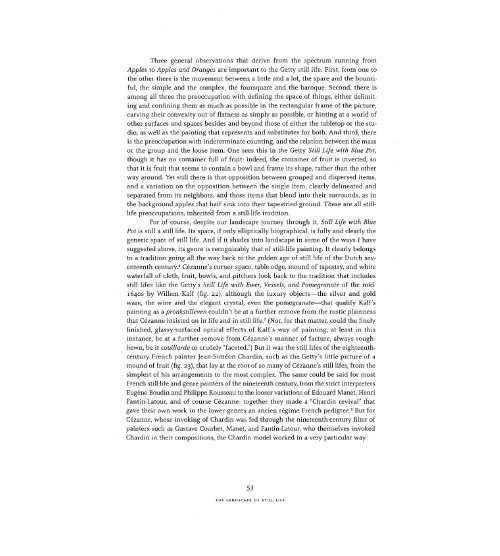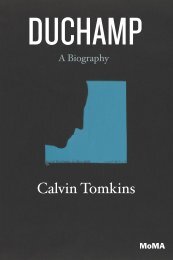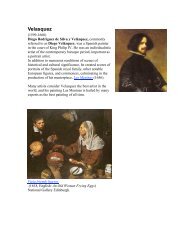Still Life in Watercolors
qbj8dgc
qbj8dgc
- No tags were found...
You also want an ePaper? Increase the reach of your titles
YUMPU automatically turns print PDFs into web optimized ePapers that Google loves.
Three general observations that derive from the spectrum runn<strong>in</strong>g from<br />
Apples to Apples and Oranges are important to the Getty still life. First, from one to<br />
the other there is the movement between a little and a lot, the spare and the bountiful,<br />
the simple and the complex, the foursquare and the baroque. Second, there is<br />
among all three the preoccupation with def<strong>in</strong><strong>in</strong>g the space of th<strong>in</strong>gs, either delimit<strong>in</strong>g<br />
and conf<strong>in</strong><strong>in</strong>g them as much as possible <strong>in</strong> the rectangular frame of the picture,<br />
carv<strong>in</strong>g their convexity out of flatness as simply as possible, or h<strong>in</strong>t<strong>in</strong>g at a world of<br />
other surfaces and spaces besides and beyond those of either the tabletop or the studio,<br />
as well as the pa<strong>in</strong>t<strong>in</strong>g that represents and substitutes for both. And third, there<br />
is the preoccupation with <strong>in</strong>determ<strong>in</strong>ate count<strong>in</strong>g, and the relation between the mass<br />
or the group and the loose item. One sees this <strong>in</strong> the Getty <strong>Still</strong> <strong>Life</strong> with Blue Pot,<br />
though it has no conta<strong>in</strong>er full of fruit: <strong>in</strong>deed, the conta<strong>in</strong>er of fruit is <strong>in</strong>verted, so<br />
that it is fruit that seems to conta<strong>in</strong> a bowl and frame its shape, rather than the other<br />
way around. Yet still there is that opposition between grouped and dispersed items,<br />
and a variation on the opposition between the s<strong>in</strong>gle item, clearly del<strong>in</strong>eated and<br />
separated from its neighbors, and those items that blend <strong>in</strong>to their surrounds, as <strong>in</strong><br />
the background apples that half s<strong>in</strong>k <strong>in</strong>to their tapestried ground. These are all stilllife<br />
preoccupations, <strong>in</strong>herited from a still-life tradition.<br />
For of course, despite our landscape journey through it, <strong>Still</strong> <strong>Life</strong> with Blue<br />
Pot is still a still life. Its space, if only elliptically biographical, is fully and clearly the<br />
generic space of still life. And if it shades <strong>in</strong>to landscape <strong>in</strong> some of the ways I have<br />
suggested above, its genre is recognizably that of still-life pa<strong>in</strong>t<strong>in</strong>g. It clearly belongs<br />
to a tradition go<strong>in</strong>g all the way back to the golden age of still life of the Dutch seventeenth<br />
century. 6 Cezanne's corner space, table edge, mound of tapestry, and white<br />
waterfall of cloth, fruit, bowls, and pitchers look back to the tradition that <strong>in</strong>cludes<br />
still lifes like the Getty's <strong>Still</strong> <strong>Life</strong> with Ewer, Vessels, and Pomegranate of the mid-<br />
16405 by Willem Kalf (fig. 22), although the luxury objects—the silver and gold<br />
ware, the w<strong>in</strong>e and the elegant crystal, even the pomegranate—that qualify Kalf ; s<br />
pa<strong>in</strong>t<strong>in</strong>g as a pronkstilleven couldn't be at a further remove from the rustic pla<strong>in</strong>ness<br />
that Cézanne <strong>in</strong>sisted on <strong>in</strong> life and <strong>in</strong> still life. 7 (Nor, for that matter, could the f<strong>in</strong>ely<br />
f<strong>in</strong>ished, glassy-surfaced optical effects of Kalf's way of pa<strong>in</strong>t<strong>in</strong>g, at least <strong>in</strong> this<br />
<strong>in</strong>stance, be at a further remove from Cezanne's manner of facture, always roughhewn,<br />
be it couillarde or crudely "faceted.") But it was the still lifes of the eighteenthcentury<br />
French pa<strong>in</strong>ter Jean-Siméon Chard<strong>in</strong>, such as the Getty's little picture of a<br />
mound of fruit (fig. 23), that lay at the root of so many of Cezanne's still lifes, from the<br />
simplest of his arrangements to the most complex. The same could be said for most<br />
French still-life and genre pa<strong>in</strong>ters of the n<strong>in</strong>eteenth century, from the strict <strong>in</strong>terpreters<br />
Eugène Boud<strong>in</strong> and Philippe Rousseau to the looser variations of Edouard Manet, Henri<br />
Fant<strong>in</strong>-Latour, and of course Cézanne: together they made a "Chard<strong>in</strong> revival" that<br />
gave their own work <strong>in</strong> the lower genres an ancien régime French pedigree. 8 But for<br />
Cézanne, whose <strong>in</strong>vok<strong>in</strong>g of Chard<strong>in</strong> was fed through the n<strong>in</strong>eteenth-century filter of<br />
pa<strong>in</strong>ters such as Gustave Courbet, Manet, and Fant<strong>in</strong>-Latour, who themselves <strong>in</strong>voked<br />
Chard<strong>in</strong> <strong>in</strong> their compositions, the Chard<strong>in</strong> model worked <strong>in</strong> a very particular way.<br />
53<br />
THE LANDSCAPE OF STILL LIFE




